Factors affecting real-world applications of HEPA purifiers in improving indoor air quality
Abstract
With modern populations spending ∼90% of their time indoors, particulate matter (PM), a significant component of indoor air quality (IAQ), is of serious concern within indoor environments. High-efficiency particulate air (HEPA) filter technologies are commonly used to remove PM. Although their performance is well defined within a laboratory setting, many aspects of their real-world use remain poorly understood. This study investigated (i) the impact of air change rate on air purifier effectiveness, and how this influences energy-efficiency and other gaseous components of indoor air quality, and (ii) the relative effectiveness of operating single and multiple air purifiers within a multi-room residence. Measurements of air change and PM concentrations made in an Asian mega-city apartment, were used alongside air purifier performance data and external PM measurements to create a box model to simulate air purifier performance under different scenarios. Increasing air change rate inhibited the performance of air purifiers by acting as a source of outdoor PM into the indoor environment. Although sealing indoor environments is recommended to maximize the removal of PM, this permits the accumulation of gaseous components of IAQ and reduces energy efficiency. Use of multiple air purifiers in a multi-room residence reduces PM at a greater rate than use of a single more powerful air purifier. Moreover, use of multiple air purifiers is more energy-efficient, although the maintenance and upfront costs are likely to be greater.

- This article is part of the themed collection: Environmental Science: Advances – Editorial and Advisory Board Member Publications


 Please wait while we load your content...
Please wait while we load your content...